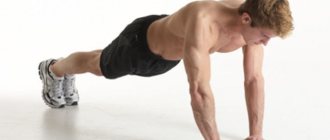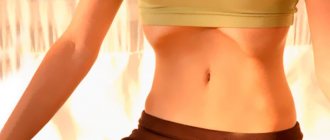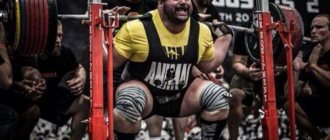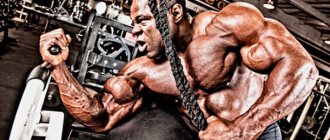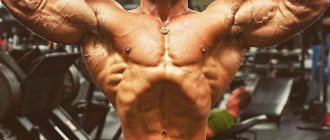Do you know how to breathe correctly when squats, because the effectiveness of the exercise, the endurance of the athlete, and safety for his health depend on this. This last point is especially important for weightlifters who squat with heavy equipment.
To understand why proper breathing when doing squats for weight loss or, conversely, for building muscle mass is so important, let's figure out what happens in the body during each inhalation and exhalation.
The important role of breathing
During the process of respiration, nutrients are broken down and energy is generated. To do this, the body needs oxygen, which is supplied to the lungs during this process. Optimal oxygenation of the lungs is the main goal of this process.
If enough oxygen is supplied, then more energy is produced in the muscles and fewer harmful breakdown products.
But if the body lacks oxygen, then physical activity will be ineffective, and a lot of lactic acid will accumulate in the muscles.
Types of breathing
Depending on the degree of change in lung volume, superficial and deep oxygen saturation are distinguished. Both types are used in sports. The superficial version is characterized by shallow depth and frequent movements of the chest. The deep variant occurs with a lower frequency but greater amplitude.
Remember the deep sigh of disappointment - a classic example of the deep method.
There are also thoracic and abdominal variants of the process. In thoracic form, the main work is performed by the chest and its muscles. This type is more typical for women. In men, the abdominal variant is more common. In this case, the load falls mainly on the abdominal muscles, which help change the volume of the lungs. This option is often used to lose weight in the abdominal area.
Smith machine squats
The Smith machine is a squat machine. For injuries to leg joints and for recovery, this is simply an indispensable exercise machine. What are its features?
- The main disadvantage is that when squatting in a machine, many stabilizer muscles are turned off, which keep the body tense and thereby increase the effectiveness of the exercise when working with free weights. But this is true if everything is fine and there are no injuries. In our case, it helps to focus specifically on the leg muscles and specifically on the injured knee.
- It is completely safe to perform squats with additional weight. It will not lead you anywhere and will not fail you. If an unforeseen dangerous situation arises, you can immediately drop the barbell onto the holders.
- If there is a back injury, then the Smith machine will also help eliminate unnecessary traumatic effects. But here it is still better to consult a doctor and a rehabilitation specialist.
When warming up, I squat without weight and follow the basic listed rules of squatting. If I take extra weight, I use a Smith machine. It is very dangerous for us injured people to do free weight squats. Especially during rehabilitation after injuries and operations on the knee joint. The Smith machine even allows you to put your legs forward a little more in order to accurately eliminate the traumatic effect on the joints and fully concentrate on the leg muscles.
Why is it important to breathe correctly?
Correct technique ensures the harmonious expenditure and supply of energy and oxygen. This issue should be taken extremely seriously: breathing affects not only the effectiveness of the exercise, but also your health. Improper execution may cause:
- feeling unwell;
- increased pressure;
- heart pain;
- dizziness;
- rapid fatigue.
Incorrect coordination of the phases of respiratory saturation and the stages of exercise will lead to greater stress on the joints and muscles. Conversely, the correct ratio will help to successfully overcome difficult moments in the exercise technique.
Breathing is also very useful for improving control of the squat technique.
Paying attention to your inhalation and exhalation during exercise will improve muscle coordination, physical memory, and nervous system control. The work will not only become more effective, you will feel your body control, even during such a natural process as inhalation and exhalation!
Newbie mistakes
Often, unprepared athletes try to lift a projectile that is too heavy. At the same time, during the positive phase, they hold their breath to the full amplitude, and, having overcome the weight, they begin to breathe heavily. This technique is fundamentally wrong.
Firstly, the heart and blood vessels of a beginner are not ready for long-term stress in the absence of oxygen, which means the risk of harm to health increases.
Secondly, rapid, repeated swallowing of air after a delay completely disrupts the respiratory rhythm, which makes the next repetition ineffective.
We recommend that you first master the exercise technique in combination with proper breathing and only after that approach power equipment.
When to watch your breathing
Contrary to popular belief, breathing movements need to be monitored from the very beginning of training.
Proper breathing is an important step in the sports life of any athlete.
But we must not forget about technique and experienced athletes. Breath control should be an integral part of any workout at any time. Over time, this will develop into automaticity, but in any case, you will need to check yourself periodically to do it correctly.
How to breathe correctly
The main rule of proper breathing during exercise is to exhale with effort. In any exercise there is a moment of maximum tension. During this period, exhalation should occur.
Thus, oxygen enters organs and tissues evenly and is spent on further loads without delays or overloads.
As you exhale, breathing most effectively supplies the muscles with everything they need without straining the cardiovascular system, because the efforts of physical activity “help” produce effort during exhalation. When doing squats, follow this simple algorithm:
- take the starting position;
- take a calm breath and exhale calmly;
- slowly begin to inhale and lower down;
- start exhaling at the lowest point;
- as you exhale, rise to the starting position.
Inhaling as you lower and exhaling as you rise are the main principles of breathing during a squat.
Subtleties of the process
To breathe truly correctly, you need to master some tricks of “quality sports” breathing in squats and lunges:
- Exhalation should be done through the mouth. But you need to inhale through your nose: this improves the supply of oxygen to the lungs, and information about this quickly reaches the brain.
- Hands should be kept in front of you. This helps expand the chest and improve coordination.
- The lowest point in a squat is considered to be the level of the thighs, parallel to the floor. The knees should not go beyond the toes, the pelvis should be in line with the knees. At this point, inhalation ends and exhalation begins.
- Before performing the exercise, you need to do a warm-up to prepare your lungs and muscles for the upcoming work. During warm-up, you should breathe through your stomach and chest alternately. The duration of this part of the exercise should be at least 5 minutes with a gradual increase in load.
- Inhalation should be done slowly throughout the entire period of lowering the body.
- Exhalation occurs faster than inhalation. It can be completed in the middle of the climb, and this will not be considered a mistake. But it is advisable to exhale during the entire lift with maximum effort at the top point at the moment of squeezing the buttocks.
- It is recommended to do 2-4 sets of 10-12 repetitions. Between approaches you need to take a break to rest and restore your breathing.
- You should not try to take very deep breaths and exhalations; the average volume of breath during exercise is 2 liters. This amount of air is felt with maximum stretching of the abdominal walls without discomfort. When the volume increases during deep breathing, there is a risk of “suffocation.” Breathing will become shallow, and the athlete will feel unpleasant shortness of breath.
Useful tips
Breathing technique during squats also includes several aspects that all athletes need to know:
- It is correct to breathe through the nose (inhale) - it has special receptors that tell the brain that the body is receiving oxygen. There are no such receptors in the mouth, so the brain itself must guess that the respiratory system is working without failures. And this is an extra burden;
- Before starting a workout, it is important to do a breathing warm-up;
- If right during the approach you feel that your breathing is out of whack, don’t be afraid to interrupt the cycle. Catch your breath, restore your heart rate and continue from where you left off;
- Here is another tip for the knowledge base on the topic “how to breathe correctly when you squat” and it is dedicated to the position of the hands. It is advisable to keep them in front of you or on your shoulders - this way you do not close the chest, allowing it to accommodate more air.
So, now you know how to breathe during squats for men and women - as you can see, the technique is not at all difficult. It is enough to understand its principle once, and then the body will intuitively work correctly. Remember, breathing skill is closely related to the technique of the exercise itself - one cannot exist without the other. Learn to breathe correctly and then any physical activity will be of no concern to you!
How to breathe correctly with your stomach
Belly breathing is rarely used in everyday life, so its technique is worth examining. Inhalation is done through the nose, the air fills the stomach, and a slight feeling of fullness appears in the stomach. The first workouts should be done on an empty stomach or an hour after eating, so as not to damage digestion.
At the moment of maximum inhalation, the front wall of the abdomen moves forward, the abdomen seems to be rounded. During exhalation, the reverse process occurs: the abdomen decreases in volume, the abdominal muscles tighten, the diaphragm pushes air from the lungs, and the exhalation ends through the mouth. During the process, pay attention to the movement of the chest: it practically does not participate in abdominal breathing, but can move passively.
Breathing while squatting with a barbell
It is recommended to move on to exercises with a barbell after fully mastering the classic version; you should not try to immediately use the breathing technique and the technique of squatting with weights, this can worsen both the performance of one and the other process.
The optimal time for developing and training breathing skills is considered to be 2-4 weeks from the moment you start training without a barbell or dumbbells.
Once this time is over, you can start training with a barbell. Just like in the usual version, you should start your workout with a short warm-up. The breathing algorithm during squats with a barbell has its own distinctive features:
- Take the starting position, take a deep breath and take a deep breath.
- Place the barbell on your shoulders. If this takes some time, continue breathing slowly and deeply.
- Take a deep breath and lower yourself until parallel to the floor.
- At the lowest point, begin to exhale slowly; jerking and sudden breathing movements should not be allowed during the ascent.
- As the body straightens, the exhalation speed can be increased, and at the moment of full straightening, exhale sharply through the mouth.
After lifting, you should move on to the next squat without resting. The same goes for squats with dumbbells.
Recommendations
The most banal recommendation I can give is to eat well. High rep squats are very energy intensive, and to get the most out of them, you need to eat a lot and eat well. Immediately after your workout, don't forget to drink a protein or high-carb shake with creatine and glutamine. Create a calorie surplus!
Recommendation two - do not use high-repetition squats for a long time. As a rule, this type of squat will bring the greatest progress only when used for the first time and no more than two, maximum three months in a row. If you use high-repetition squats for longer, there is a high probability of overloading the central nervous system. Use the principles of cycling and periodization, and approach your training wisely.


